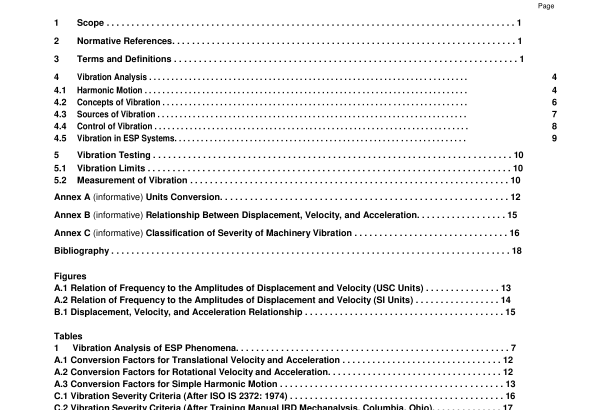API RP 6DR:2012 pdf free download.Recommended Practice on Electric Submersible System Vibrations
4.2 Concepts of Vibration Vibration is a term that describes oscillation in a mechanical system. It is defined by the frequency (or frequencies) and amplitude. An excitation or oscillating force applied to the system is vibration in a generic sense. Conceptually, the ensemble or time-history of vibration may be considered sinusoidal or simple harmonic in form. Although vibration encountered in practice often does not have this regular pattern, it may be a combination of several sinusoidal quantities, each having a different frequency and amplitude. If the vibration ensemble repeats itself after a determined interval of time, the vibration is termed periodic. Mechanical systems experiencing forced vibrations continue under steady-state conditions because energy is supplied to the system continuously to compensate for that dissipated by damping in the system.
In a free vibrating system, there is no energy added to the system, but rather the vibration is the continuing result of an initial disturbance. In the absence of damping, free vibration is assumed to continue indefinitely. In general, the frequency at which energy is supplied (i.e. the forcing frequency) appears in the vibration of the system. The vibration of the system depends upon the relation of the excitation or forcing function to the properties of the system. This relationship is a prominent feature of the analytical aspects of vibration. The technology of vibrations embodies both theoretical and experimental facets. These methods of analysis and instruments for the measurement of vibration are of primary significance. The results of analysis and measurement are used to evaluate vibration environments, to devise testing procedures and instruments, and to design and operate equipment and machinery. The objective is to eliminate or reduce vibration severity or, alternatively, to design equipment to withstand its influences.
4.3 Sources of Vibration
4.3.1 General Several potential sources of vibration are discussed in the following paragraphs. The correspondence between observed vibratory response frequencies and the likely cause of that response is shown in Table 1 .
Misaligned couplings of shaft bearings can result in transverse vibration (vibration perpendicular to the shaft). Flexible couplings with angular misalignment may produce an axial mode of vibration. This is especially prominent in slender, long shafts. Misalignment may result in large axial vibration. A characteristic of misalignment and bent shafts is that vibration will occur in both radial and axial directions. In general, whenever the amplitude of axial vibration is greater than 50 % of the highest radial vibration, then misalignment or a bent shaft should be suspected.
4.3.4 Flow Induced Pump vibration can occasionally be caused by flow through the system. The amplitude usually depends upon where the pump is operated on the head-capacity curve. This normally causes a vibration due to turbulence. In diffuser-type pumps, certain combination of impeller blades and diffuser vanes are more likely to produce vibration than others. Although this phenomenon can produce vibration amplitudes that are unacceptable, especially at rates conducive to cavitation problems, testing indicates that when the pump is operated within its recommended operating range, the impact of turbulence is minimal. Nonsymmetrical fluid passages in a pump can induce hydraulic imbalance that may be seen as a once per revolution vibration. Multiphase flow can also induce vibration.
4.3.5 Journal Bearing Oil Whirl A condition caused by hydrodynamic forces in lightly loaded journal bearings that results in a vibration at slightly less than one-half (42 % to 48 %) the rotating frequency.
4.3.6 Bearing Rotation Journal bearings that are not properly secured can rotate with the shaft and produce vibration at one-half rotating frequency.
4.3.7 Mechanical Rub Contact between the rotating and stationary surfaces results in a vibration at a frequency normally 1 / 3 to 1 / 2 the operating speed. Natural frequencies may be excited. API RP 6DR pdf download.API RP 6DR:2012 pdf free download
